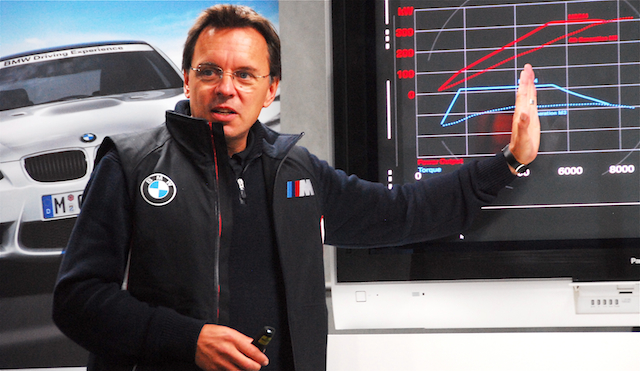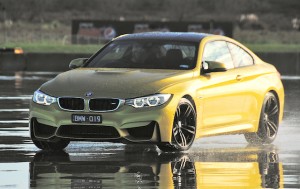
Above: Joerg Bartels, head of sales operations for BMW in Munich
A weight difference of 23kg between the two-door BMW M4 and four-door M3 mightn’t seem a lot, but it was very much a talking point at the launch in New Zealand this week of both high-performance cars.
It wasn’t as spirited as the debate over BMW’s decision of a couple of years ago to turn the hallowed two-door M3 into a two-door M4, and a four-door M3 into a … well, four-door M3. Most are over that now.
But the weight difference raised a quizzical eye or two, especially after time on the Hampton Downs track and skidpan: is the slightly heavier sedan (1595kg) a better balanced performer than the (1572kg) coupe? Some experienced drivers, racetrack regulars, think it is.

Both rear-drive cars share the same turbocharged 3.0-litre straight-six engine, good for 317kW and 550Nm. Both sprint from 0-100km/h in a claimed 4.3 seconds, both have the same in-gear acceleration times, both swallow the same amount of fuel … both do this, both do that. They’re twins, although different.
So how is it that the M3 somehow ticked another box or two? Is it all in the mind, because of the design: the M3 hides its furious intent and the M4 shows it off? Is it the M3 badge? Does it have a gatekeeper? Did the ghosts of BMW engineers who hankered for an M division more than 40 years ago wander the workshop at night to tinker and protect the M3’s provenance? After all, M3 drives the M division and has done since 1986. It is more than just a product – it’s a touchstone.
The four-door M3 has a little more weight from the middle of the car back. It uses a steel and carbon-fibre band across the roof to tie the two sides together; it has two rear doors; and a steel boot lid. The two-door M4 has an all-carbon-fibre roof, lacks rear doors, and has a lightweight boot lid. There’s the 23kg difference.
Does the combination of steel and carbon fibre in the sedan’s roof band make a subtle difference? Do the rear doors and the steel boot lid add a touch more weight around the rear axle? Engineer Joerg Bartels, head of sales operations for BMW in Munich, said the weight difference is negligible. The cars remain lighter and stronger than predecessors, he said.
But asked if one of BMW’s test drivers might notice the difference, he said: “BMW test drivers are very good and, yes, it is possible they could tell there was a difference. But most people couldn’t tell; both cars are so beautifully balanced.”

They are indeed, but … preferences aside, both come with electronic gadgets galore that can be programmed to suit each owner’s habits. The electrically-assisted steering is weight-variable but pin sharp, a far cry from BMW’s first electric set-up in the Z4. The engineer in charge of steering wanted a traditional hydraulic rack for the M3 and M4 but was told it had to be electric. “He said ‘I will find a way; I will do it,’” said Bartels.
Take it as read that the mix of ride/handling/power delivery is another highlight, thanks largely to the boosted 3.0-litre engine’s 550Nm of torque on tap between 1850-5500rpm. Once, the engines in BMW’s were peaky, at their best at the top end of the rev range. Same with other carmakers. Staying high in the rev range on a spirited drive meant working the throttle and gearbox to find the right ratio. Result: much toil and less fuel.
That was then; the BMW M3 and M4 and a world of new technology is now. The wide torque band invites a different driving style – it allowed the coupe and sedan to carry the demanding corners at Hampton Downs in fourth gear and then power away on the straights. It was an experiment, purely to show off how the engine and the seven-speed duel-clutch gearbox can work as one.
Away from the track, at street-legal speeds on Highway One, the powertrain will allow the M3/M4 to roll along on a wave of torque . The trick will be to better BMW’s claimed fuel economy of 8.3 litres/100km, or 34mpg. It wasn’t that long ago that BMW boasted its then M3 was good for 12.1 litres/100km, or 23mpg. The price of the car was about the same as it is now. But these new cars come with so much more. There’s another difference.
• The M3 is listed in New Zealand at $159,900, the M4 at $169,900.

